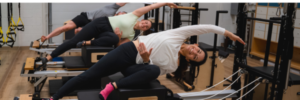It can sometimes be hard to find time to support and empower our bodies properly with a busy schedule. When we put health initiatives on the back burner, we increase the risk of developing certain injuries and diseases. There are a few things that we can do to help support us through our busy day.
Proper Footwear
First thing we can do is ensure that we are wearing footwear that is supportive and fits us properly. When our feet are supported, it can help to reduce fatigue in our legs and the rest of the body.
Footwear Tips:
- Length: We want at least a half of thumbs width from the top of the longest toe to the top of the shoe. It is recommended to have a full thumb width in running shoes, hikers and shoes you plan to do lots of walking in. This allows for more room to compensate for swelling or expansion of our muscles once oxygen and blood start to circulate.
- Width: In terms of width, you want something that accommodates your forefoot and all toes equally, not something that squeezes your toes or cuts off the fifth toe.
- Cushion: Shoes with a greater cushioned sole offer more support and more absorption of shock from impact on hard surfaces. An increase in shock absorption can help to take force off of knees and hips decreasing sore and fatigued legs at the end of the day. *** Extra Tip**** Combine a cushioned sock with a cushioned shoe and you got yourself a total cushioned package.
Physical Activity and Exercise
Some of us do not have the time to spend hours at the gym, or go for runs. While these are known to have positive impacts on health, it is more beneficial to do what your lifestyle can accommodate. To start, find at least 15 minutes a day to incorporate some sort of movement. Once you have incorporated 15 minutes, try bumping it up to 30 minutes a day or every two days. Eventually the goal is to have 150 minutes of activity in a week, with two days of resistance training. This combined with other health initiatives has been shown to decrease blood pressure, and help lower the risk of developing cardiovascular disease and type 2 diabetes.
Physical Activity and Exercise Ideas:
- 15 minute walk at lunch around the block
- 10 jumping jacks
- Bend over and touch your toes 10 times
- Pilates class
- Boxing or selfdefense classes
- Yoga class
- HIIT or Crossfit class
- Cross country ski
- Bike ride along the mission greenway trail
“30 minutes of exercise or physical activity a day, combined with other health initiatives has been shown to decrease blood pressure, and help lower the risk of developing cardiovascular disease and type 2 diabetes”.
Nutritious fuel for your body
The last thing we can do to impact big health changes is to think consciously about what we are eating to fuel our bodies. Ensuring that we are eating enough throughout the day can help with the afternoon crash. If you are a person that always feels tired at a certain time in the afternoon and find it hard to get through the remainder of the day, try having a snack that is protein dominant with your afternoon coffee. If you are a person that skips breakfast, finding a way to make up for that missed meal throughout the day will help with that afternoon fatigue as well.
There is no ideal diet for everyone, but ensuring that you eat proteins, carbohydrates and fruit/veggies in their purest form with every food intake will help to have a more rounded nutritious diet. When we have a more rounded diet, the body is able to use all the macronutrients for energy, instead of relying on stores in the body.
Nutritious Food Snack Ideas:
- Greek yogurt with 1 cup of berries and a drizzle of honey
- Cheese, meat and crackers
- Apples or Celery with peanut butter
- Cashews, a banana and mini rice cakes
There are many more small changes that can have a big impact on health. Give us a call or book an assessment with a Kinesiologist or Pedorthic to learn more. They can offer a more tailored plan to fit your needs and goals through an assessment of your movements.




